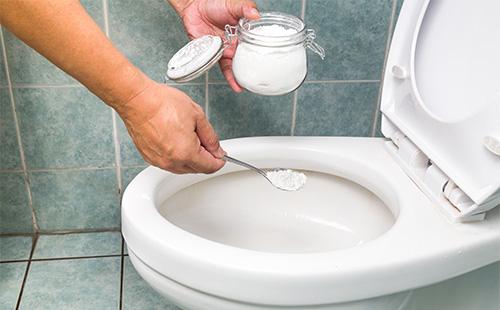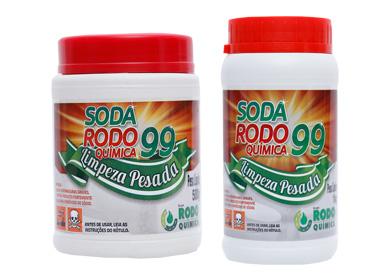The content of the article
Caustic soda, caustic, sodium hydroxide are different names for caustic soda (NaOH). This is a powerful alkali. The powder substance is a small scaly granules of white color, without a pronounced odor. They are hygroscopic and have the ability to dissolve well in water with the release of a large amount of heat. Caustic soda is available in liquid and powder form. Caustic is used in such industries as:
- chemical;
- Automotive
- light
- metallurgical;
- gas;
- oil.
Differences of caustic soda from other types of soda
Despite the fact that caustic, soda ash and baking soda belong to the same group of sodium compounds, there are still differences.
- According to the chemical formula. In calcined it is Na2CO3, and in food - NaHCO3.
- By force. The softest is baking soda, the second is calcined, and the undisputed leader is caustic. Caustic is able to cope with the most severe pollution and blockages. Calcined and food is not a force.
- For safety. Caustic soda is much more aggressive than all "relatives" and has an increased hazard class, therefore, when working with it, safety precautions must be observed.
Sewer Pipe Control
Where is such rubber soda used and how to breed at home? Before starting work, you need to make sure that contact with the caustic passes without consequences. Rubber gloves, goggles, a protective mask are mandatory attributes. Sodium hydroxide has the ability to immediately dissolve fat, no matter how long it has. In addition, it is cheaper than imported cleaning products. 1 kg of powder caustic for technical cleaning will cost an average of 80 rubles (data for June 2018). Caustic can be found in the basis of the formula of ready-made products, for example, as part of the "Mole".
If you live in a private house, then to eliminate blockages you need 3 kg of powder caustic, and 2 kg is enough in an apartment building. You will also need a plastic bucket with thick walls with a volume of 10-12 liters and a convenient scoop or scoop.
The process of preparing the solution is as follows. Pour the right amount of alkali into the bucket. Carefully fill with cold water, but not to the very top, but a little more than half (6-7 liters), mix well. As soon as the chemical reaction is over, the composition is ready.
Solution
Features Iron and steel can withstand this processing method, but not plastic pipes - the caustic can simply corrode the surface of the material. If the blockage is small, it is enough to carry out the procedure once. In advanced cases, manipulations must be repeated in two weeks.
Your actions
- Gently pour about half of the total weight of the resulting caustic solution into the drain hole.
- Make sure that the product is not sprayed onto the surface of the floor or sink - caustic can corrode enamel.
- Wait about two to three hours (do not use plumbing).
- Pour the rest of the solution, wait the same amount of time.
- Turn on the water and pour it into the drain with maximum power for 10-15 minutes.
- If you live in an ordinary apartment building, then the solution does not need to be divided into two doses - fill it all at once. Otherwise, the manipulations are the same.
Dry method
Features The method is one of the most effective, but requires maximum accuracy. Suitable for prophylaxis and disinfection, as well as after the treatment of sewage with acidic agents - this way you can neutralize the aggressive effect of acid. Keep in mind that with a “dry” cleaning method, pipes may be damaged.
Your actions
- Pour 2-3 liters of hot water into the drain. This is done to warm the pipes and increase the efficiency of the procedure.
- Two or three tablespoons of powdered or granular caustic soda (in advanced cases, you can even take one glass), pour in the drain. Make sure that the substance does not scatter on the surface of the sinks, toilet bowl and bathtub.
- Then pour hot water (just 200-250 ml is enough).
- Wait two or three hours for the chemical reactions to go through completely.
- Turn on the tap at full power and flush the solution.
Gel
Features Liquid caustic is less effective in controlling blockages, but is safer and more convenient to use. Ideal for preventive purposes. It is enough to repeat the cleaning once or twice a month.
Your actions
- Shake the gel thoroughly without opening.
- Pour into a drain about a glass or a little more (take care of enameled surfaces).
- After him fill a glass of hot water and wait two to three hours.
- Open the tap to maximum pressure, pour into the drain 10-15 minutes. This time will be enough to soften the remnants of dirt washed off.
Cesspool cleaning
Features The ingress of caustic into the soil affects the soil negatively. Therefore, the pit must be absolutely leakproof and have a working ventilation system.
Your actions
- Prepare the mortar according to the same principle as described above for sewer pipes. Depending on the size of the pit, 2-4 kg of caustic soda will be required.
- Pour the mixture into the waste pit.
- As a rule, the period of activity of the drug lasts about four minutes.
- The cycle must be repeated twice.

Domestic use
In everyday life, caustic is often used to remove contaminants. It has the ability to neutralize even the most old fat.
We clean the dishes
Features Do not use Teflon or aluminum cookware. But enameled, cast-iron and steel dishes after such procedures look like new.
Your actions
- Take a large metal container and pour at least 10 liters of water into it.
- Pour about 200 g of caustic into the liquid.
- Add shavings of laundry soap obtained from one bar.
- Pour 150 g of "liquid glass" (it is also called clerical glue).
- Stir all this thoroughly and place in the solution dishes that require cleaning.
- Put on a slow fire, wait until the solution boils and hold for another couple of hours.
- After the specified time, remove the utensils and rinse thoroughly with water.
Cook soap
Features A self-obtained product is no worse than expensive analogues: it foams well and has excellent cleansing properties.Only caustic needs to be used with the highest degree of purification with the markings ChP and ChDA (“chemically pure” and “pure for analysis”, respectively). As a rule, it is sold in soap stores and can cost from 150 to 500 rubles per 1 kg (data for June 2018).
Your actions
- Heat a little 0.5 l of vegetable oil.
- Mix distilled water (150 ml) and caustic soda (70 g).
- Combine the mixture with oil.
- Mix the solution thoroughly with a wooden spatula, wait until the caustic soda has completely dissolved and get a thick consistency.
- Add two to three tablespoons of any aromatic herbs or five to six drops of your favorite aromatic essential oils for smell.
- Pour the gel-like substance into a rectangular container and leave it alone for four days in a dry place.
- After this time, cut a soap with a sharp knife into pieces of the required size and, if necessary, leave the resulting products to ripen.
Other areas
The scope of application of sodium hydroxide due to its unique ability to corrode any dirt and leave behind a sterile cleanliness is quite extensive: both at home, in its summer cottage, and even in animal husbandry.
- Rust. To restore the original appearance to the pipes, they are first treated with acidic agents, and then a mixture of caustic soda, formalin and ammonium diluted with water (in equal proportions) is applied.
- Stains from fuel oil and stubborn fat. To rid things of especially strong pollution, soak them and leave them for two to three hours in a solution of 2% caustic (a tablespoon per liter of water). After that wash as usual. Particularly brave housewives even use caustic in an automatic machine. Three to five tablespoons are poured directly into the drum and the cycle starts at a temperature of 50-100oC. If you are going to wash by hand, then the proportions are three tablespoons of caustic per 10 liters of water. Do not try to clean wool and silk fabrics in this way - irreparable harm will be caused to delicate materials.
- Mopping. For 10 liters of liquid, you need three tablespoons of a powdery substance. Wipe the surface with a solution, and then go with clean water and wipe it dry.
- Disinfection. In case of livestock disease, a 4% solution of caustic is used to treat rooms where animals are kept.
- Processing plants. Gardeners using caustic soda (five tablespoons per bucket of water) process the bushes. This process will not give a chance for caterpillars, gray rot and powdery mildew to survive. Caustic is able to accumulate inside the soil. Therefore, such procedures should not be carried out regularly.

Safety regulations
Sodium hydroxide is a powerful alkali that can corrode even hard materials. Precautions must be taken to maintain your health and surface integrity.
- Wear protective equipment. Before starting the procedure, arm yourself with glasses and a mask, rubber gloves should reach the elbow, clothes should be tight and not leaving open areas of the body. This will protect you from chemical burns.
- Wait for the reaction to complete. Since caustic, interacting with water, is capable of generating heat, you should not immediately begin to carry out procedures with it. Wait a few minutes until the chemical reactions are complete.
- Do not spray the product. Surfaces, especially enamelled, can be affected.
- Avoid contact with skin. In case of contact with exposed areas of the body or eyes, rinse immediately with running water. Then treat with 2% boric acid. If after half an hour burning, redness still does not go away - seek medical help.
- Store correctly. Caustic should be stored in a well-closed iron or glass jar.It should not be freely available, as it is toxic and explosive.
Remember that frequent use of caustic can destroy the surface of even the most durable materials.
Reviews
I have been using caustic soda for a long time, and my parents used it. For sewerage, I consider it the best option, the main thing is not to run to such an extent that mechanical cleaning is needed. I even use this soda for prophylaxis, just pour it into the drain, and spill it with hot water. So the drain is not contaminated, especially if you do this at least once every two to three months. By the way, caustic soda helps to wash things that are very oily with machine oil, for example, work clothes. I buy caustic soda in powder, so it seems to me more convenient to dose.
Nina Alexandrovna, http://kvartirnyj-remont.com/primenenie-kausticheskoj-sody-dlya-chistki-kanalizacii.html
In our house, all the pipes and all the plumbing, everything is very old. In the kitchen there were constant blockages, they took advertised products such as tyreth, of course it helped but not for long. Is there any need to explain that these funds are flying out a pretty penny. Then we were told about caustic soda. Bought, tried, liked it. The main thing is that it is affordable. There are still blockages, but this is rare.
Maria, http://postwater.ru/kanalizaciya/v-chastnom-dome/kausticheskaya-soda.html

